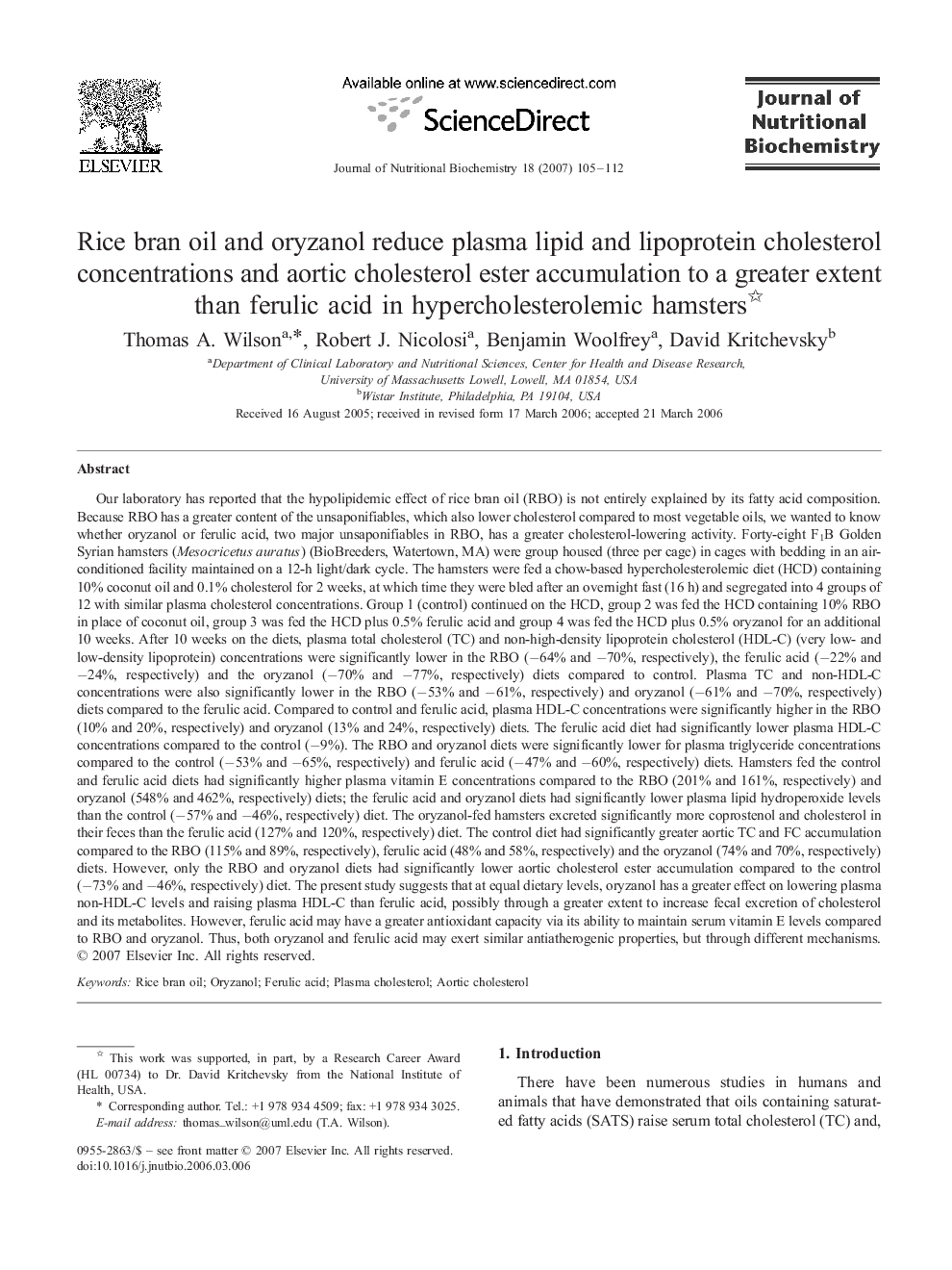| کد مقاله | کد نشریه | سال انتشار | مقاله انگلیسی | نسخه تمام متن |
|---|---|---|---|---|
| 1990815 | 1540748 | 2007 | 8 صفحه PDF | دانلود رایگان |

Our laboratory has reported that the hypolipidemic effect of rice bran oil (RBO) is not entirely explained by its fatty acid composition. Because RBO has a greater content of the unsaponifiables, which also lower cholesterol compared to most vegetable oils, we wanted to know whether oryzanol or ferulic acid, two major unsaponifiables in RBO, has a greater cholesterol-lowering activity. Forty-eight F1B Golden Syrian hamsters (Mesocricetus auratus) (BioBreeders, Watertown, MA) were group housed (three per cage) in cages with bedding in an air-conditioned facility maintained on a 12-h light/dark cycle. The hamsters were fed a chow-based hypercholesterolemic diet (HCD) containing 10% coconut oil and 0.1% cholesterol for 2 weeks, at which time they were bled after an overnight fast (16 h) and segregated into 4 groups of 12 with similar plasma cholesterol concentrations. Group 1 (control) continued on the HCD, group 2 was fed the HCD containing 10% RBO in place of coconut oil, group 3 was fed the HCD plus 0.5% ferulic acid and group 4 was fed the HCD plus 0.5% oryzanol for an additional 10 weeks. After 10 weeks on the diets, plasma total cholesterol (TC) and non-high-density lipoprotein cholesterol (HDL-C) (very low- and low-density lipoprotein) concentrations were significantly lower in the RBO (−64% and −70%, respectively), the ferulic acid (−22% and −24%, respectively) and the oryzanol (−70% and −77%, respectively) diets compared to control. Plasma TC and non-HDL-C concentrations were also significantly lower in the RBO (−53% and −61%, respectively) and oryzanol (−61% and −70%, respectively) diets compared to the ferulic acid. Compared to control and ferulic acid, plasma HDL-C concentrations were significantly higher in the RBO (10% and 20%, respectively) and oryzanol (13% and 24%, respectively) diets. The ferulic acid diet had significantly lower plasma HDL-C concentrations compared to the control (−9%). The RBO and oryzanol diets were significantly lower for plasma triglyceride concentrations compared to the control (−53% and −65%, respectively) and ferulic acid (−47% and −60%, respectively) diets. Hamsters fed the control and ferulic acid diets had significantly higher plasma vitamin E concentrations compared to the RBO (201% and 161%, respectively) and oryzanol (548% and 462%, respectively) diets; the ferulic acid and oryzanol diets had significantly lower plasma lipid hydroperoxide levels than the control (−57% and −46%, respectively) diet. The oryzanol-fed hamsters excreted significantly more coprostenol and cholesterol in their feces than the ferulic acid (127% and 120%, respectively) diet. The control diet had significantly greater aortic TC and FC accumulation compared to the RBO (115% and 89%, respectively), ferulic acid (48% and 58%, respectively) and the oryzanol (74% and 70%, respectively) diets. However, only the RBO and oryzanol diets had significantly lower aortic cholesterol ester accumulation compared to the control (−73% and −46%, respectively) diet. The present study suggests that at equal dietary levels, oryzanol has a greater effect on lowering plasma non-HDL-C levels and raising plasma HDL-C than ferulic acid, possibly through a greater extent to increase fecal excretion of cholesterol and its metabolites. However, ferulic acid may have a greater antioxidant capacity via its ability to maintain serum vitamin E levels compared to RBO and oryzanol. Thus, both oryzanol and ferulic acid may exert similar antiatherogenic properties, but through different mechanisms.
Journal: The Journal of Nutritional Biochemistry - Volume 18, Issue 2, February 2007, Pages 105–112